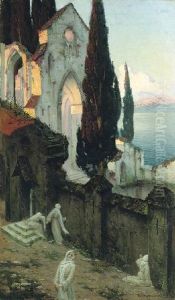Mikhail Mikhailovich Adamovich Paintings
Mikhail Mikhailovich Adamovich was a notable Russian and Soviet artist primarily recognized for his work in ceramics and porcelain. Born on November 19, 1884, in the city of Orekhovo-Zuyevo, near Moscow, Adamovich was part of a generation of artists who witnessed and contributed to the dramatic transformations of Russian art during the early 20th century.
Adamovich studied at the Stroganov Moscow State University of Arts and Industry, where he honed his skills in drawing and decorative painting. His early career was marked by his work with traditional ceramics, but he soon became involved with the more avant-garde movements of the time. After the Russian Revolution of 1917, he embraced the Bolshevik cause and sought to apply his artistic talents to the new Soviet reality.
During the 1920s, Adamovich became one of the leading artists at the State Porcelain Factory (formerly the Imperial Porcelain Factory) in Petrograd (now Saint Petersburg). He was instrumental in redefining the aesthetic of porcelain art, infusing it with the dynamism and ideological fervor of the Constructivist and Suprematist movements. His designs often featured bold geometric shapes, vibrant colors, and socialist political themes. Adamovich collaborated with other prominent artists, such as Kazimir Malevich and Nikolai Suetin, to produce pieces that reflected the utopian aspirations of the early Soviet period.
His work from this period is characterized by its innovative use of the porcelain medium to convey political messages. Plates, vases, and other items were adorned with symbols of the Soviet state, such as the hammer and sickle, red stars, and portraits of Lenin and other leaders. These items were not only works of art but also served as propaganda tools to spread the ideals of communism.
As the political climate in the Soviet Union shifted in the 1930s, Adamovich's style evolved as well. The Stalinist regime favored more conservative and traditional forms of art that promoted Soviet nationalism and realism over the avant-garde styles of the previous decade. Adamovich adapted to these changes and continued to produce work, although the radical edge of his earlier pieces was no longer as prominent.
Mikhail Mikhailovich Adamovich's contributions to the field of Soviet porcelain art were significant, and his works remain a testament to the complex interplay between art and politics during a tumultuous period in Russian history. He passed away on January 16, 1947, in Moscow, leaving behind a legacy that continues to be studied and appreciated by art historians and collectors alike.
